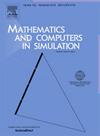评估非流行地区蚊媒疾病的风险:一种动态建模方法
IF 4.4
2区 数学
Q1 COMPUTER SCIENCE, INTERDISCIPLINARY APPLICATIONS
引用次数: 0
摘要
蚊媒疾病正在向温带地区蔓延,引起人们对由输入病例引起的当地疫情的担忧。使用随机方法,我们开发了一个媒介-宿主模型来估计非流行地区由进口驱动的本地暴发的风险。该模型探讨了输入病例和媒介丰度等关键因素。我们的分析表明,蚊子种群丰度显著影响暴发的概率和时间。即使蚊子数量不多,也可能引发孤立或聚集性疫情,这突出了监测病媒数量对有效的公共卫生规划和干预措施的重要性。本文章由计算机程序翻译,如有差异,请以英文原文为准。
Evaluating the risk of mosquito-borne diseases in non-endemic regions: A dynamic modeling approach
Mosquito-borne diseases are spreading into temperate zones, raising concerns about local outbreaks driven by imported cases. Using stochastic methods, we developed a vector-host model to estimate the risk of import-driven autochthonous outbreaks in non-endemic regions. The model explores key factors such as imported cases and vector abundance. Our analysis shows that mosquito population abundance significantly affects the probability and timing of outbreaks. Even with moderate mosquito populations, isolated or clustered outbreaks can be triggered, highlighting the importance of monitoring vector abundance for effective public health planning and interventions.
求助全文
通过发布文献求助,成功后即可免费获取论文全文。
去求助
来源期刊

Mathematics and Computers in Simulation
数学-计算机:跨学科应用
CiteScore
8.90
自引率
4.30%
发文量
335
审稿时长
54 days
期刊介绍:
The aim of the journal is to provide an international forum for the dissemination of up-to-date information in the fields of the mathematics and computers, in particular (but not exclusively) as they apply to the dynamics of systems, their simulation and scientific computation in general. Published material ranges from short, concise research papers to more general tutorial articles.
Mathematics and Computers in Simulation, published monthly, is the official organ of IMACS, the International Association for Mathematics and Computers in Simulation (Formerly AICA). This Association, founded in 1955 and legally incorporated in 1956 is a member of FIACC (the Five International Associations Coordinating Committee), together with IFIP, IFAV, IFORS and IMEKO.
Topics covered by the journal include mathematical tools in:
•The foundations of systems modelling
•Numerical analysis and the development of algorithms for simulation
They also include considerations about computer hardware for simulation and about special software and compilers.
The journal also publishes articles concerned with specific applications of modelling and simulation in science and engineering, with relevant applied mathematics, the general philosophy of systems simulation, and their impact on disciplinary and interdisciplinary research.
The journal includes a Book Review section -- and a "News on IMACS" section that contains a Calendar of future Conferences/Events and other information about the Association.
 求助内容:
求助内容: 应助结果提醒方式:
应助结果提醒方式:


